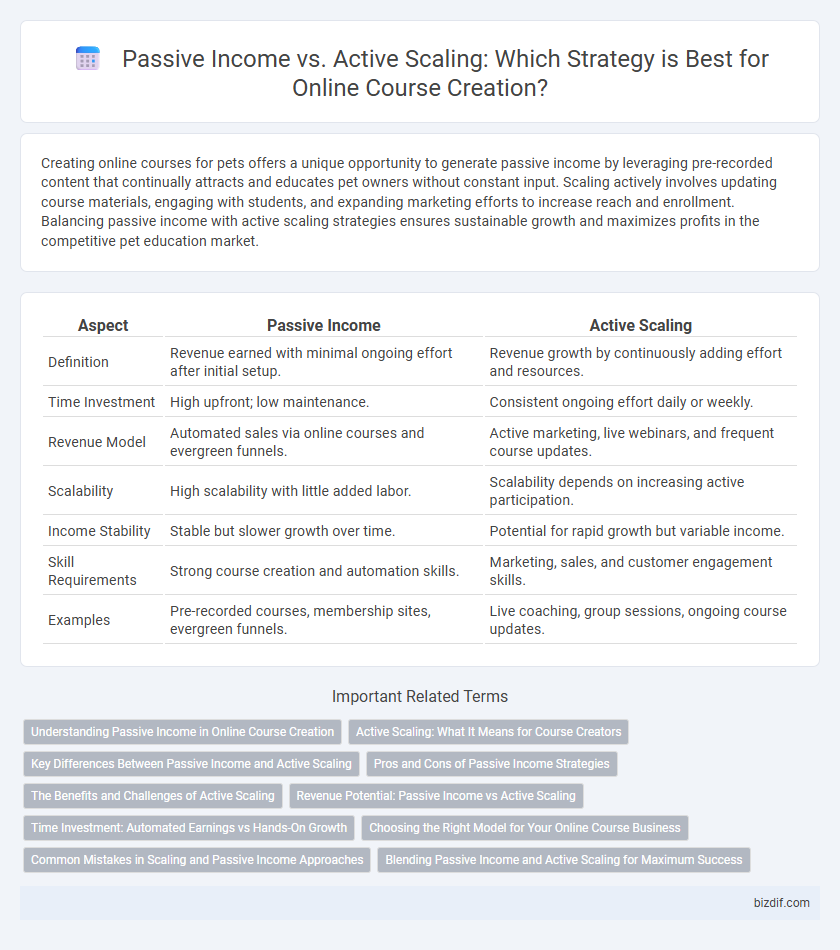Creating online courses for pets offers a unique opportunity to generate passive income by leveraging pre-recorded content that continually attracts and educates pet owners without constant input. Scaling actively involves updating course materials, engaging with students, and expanding marketing efforts to increase reach and enrollment. Balancing passive income with active scaling strategies ensures sustainable growth and maximizes profits in the competitive pet education market.
Table of Comparison
| Aspect | Passive Income | Active Scaling |
|---|---|---|
| Definition | Revenue earned with minimal ongoing effort after initial setup. | Revenue growth by continuously adding effort and resources. |
| Time Investment | High upfront; low maintenance. | Consistent ongoing effort daily or weekly. |
| Revenue Model | Automated sales via online courses and evergreen funnels. | Active marketing, live webinars, and frequent course updates. |
| Scalability | High scalability with little added labor. | Scalability depends on increasing active participation. |
| Income Stability | Stable but slower growth over time. | Potential for rapid growth but variable income. |
| Skill Requirements | Strong course creation and automation skills. | Marketing, sales, and customer engagement skills. |
| Examples | Pre-recorded courses, membership sites, evergreen funnels. | Live coaching, group sessions, ongoing course updates. |
Understanding Passive Income in Online Course Creation
Passive income in online course creation involves generating revenue with minimal ongoing effort, allowing course creators to earn continuously after initial content development. This approach leverages automated sales funnels, evergreen content, and subscription models to maximize long-term profitability without constant active involvement. Understanding passive income enables creators to focus on producing high-quality courses that sustain income streams over time while balancing scalability and workload.
Active Scaling: What It Means for Course Creators
Active scaling for course creators involves continuously improving course content, engaging with students, and expanding marketing efforts to drive sustainable growth. Unlike passive income, which relies on set-it-and-forget-it methods, active scaling demands strategic input and real-time adaptation to market trends. This hands-on approach maximizes revenue potential through personalized learning experiences and targeted audience expansion.
Key Differences Between Passive Income and Active Scaling
Passive income from online course creation generates revenue through automated sales funnels and evergreen content, requiring minimal ongoing effort once established. Active scaling involves continuous marketing, content updates, and direct audience engagement to grow course enrollment and revenue rapidly. Key differences include the time investment, with passive income focusing on initial setup and active scaling demanding consistent, hands-on management.
Pros and Cons of Passive Income Strategies
Passive income strategies in online course creation offer scalability and ongoing revenue with minimal daily effort, enabling creators to reach a global audience without continuous content updates. However, these approaches often require significant upfront investment in course quality, marketing automation, and platform optimization, and they may suffer from slower growth compared to active engagement methods. The lack of real-time interaction can limit personalized feedback and customer relationships, potentially impacting long-term brand loyalty and course improvement.
The Benefits and Challenges of Active Scaling
Active scaling in online course creation enables rapid revenue growth through targeted marketing and course expansion, leveraging continuous content updates and audience engagement. This approach demands consistent effort, resource investment, and agility to adapt to market trends, presenting challenges such as increased workload and the need for advanced technical skills. Despite these hurdles, active scaling offers greater control over course quality, personalized learner experiences, and sustainable long-term income potential compared to passive income models.
Revenue Potential: Passive Income vs Active Scaling
Passive income from online courses generates consistent revenue with minimal ongoing effort, leveraging evergreen content and automated sales funnels for sustained profitability. Active scaling involves investing time and resources in marketing campaigns, live sessions, and course updates to rapidly increase revenue but requires continuous engagement and operational input. Balancing passive income streams with strategic active scaling maximizes overall revenue potential in the competitive online education market.
Time Investment: Automated Earnings vs Hands-On Growth
Passive income from online courses relies on automated sales funnels and evergreen content, enabling creators to earn consistently with minimal ongoing effort. Active scaling demands significant time investment for continuous content updates, marketing strategies, and student engagement to drive growth. Balancing automated earnings with hands-on development maximizes revenue potential while optimizing long-term time management.
Choosing the Right Model for Your Online Course Business
Choosing the right model for your online course business depends on balancing passive income streams with active scaling efforts. Passive income involves creating evergreen courses that generate revenue with minimal ongoing input, while active scaling requires continuous marketing, course updates, and customer engagement to expand reach and profitability. Evaluating market demand, course content, and personal involvement helps optimize long-term growth and sustainable revenue.
Common Mistakes in Scaling and Passive Income Approaches
Many online course creators mistake passive income as entirely hands-off, underestimating the ongoing effort required for marketing, content updates, and customer engagement. Overemphasizing automation without proper scaling strategies often leads to stagnant growth and missed revenue opportunities. Implementing active scaling methods such as targeted advertising, community building, and personalized support can complement passive income models to maximize long-term profitability.
Blending Passive Income and Active Scaling for Maximum Success
Blending passive income and active scaling strategies enhances revenue growth in online course creation by combining automated sales with targeted marketing efforts. Passive income generated through evergreen courses provides steady cash flow, while active scaling involves live webinars and personalized coaching to boost engagement and conversions. Leveraging both methods maximizes profitability and sustains long-term business expansion.
Passive income vs Active scaling Infographic

 bizdif.com
bizdif.com